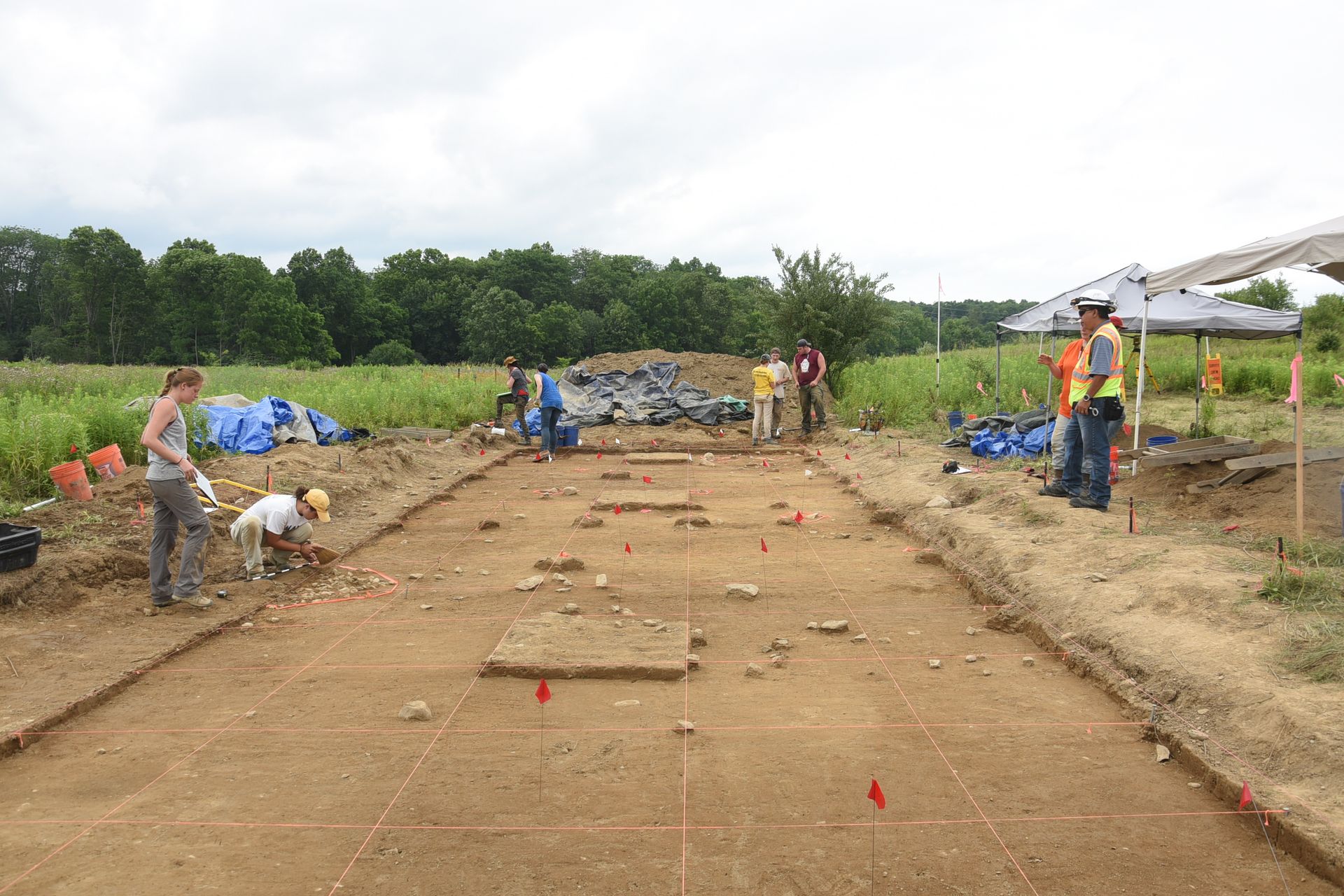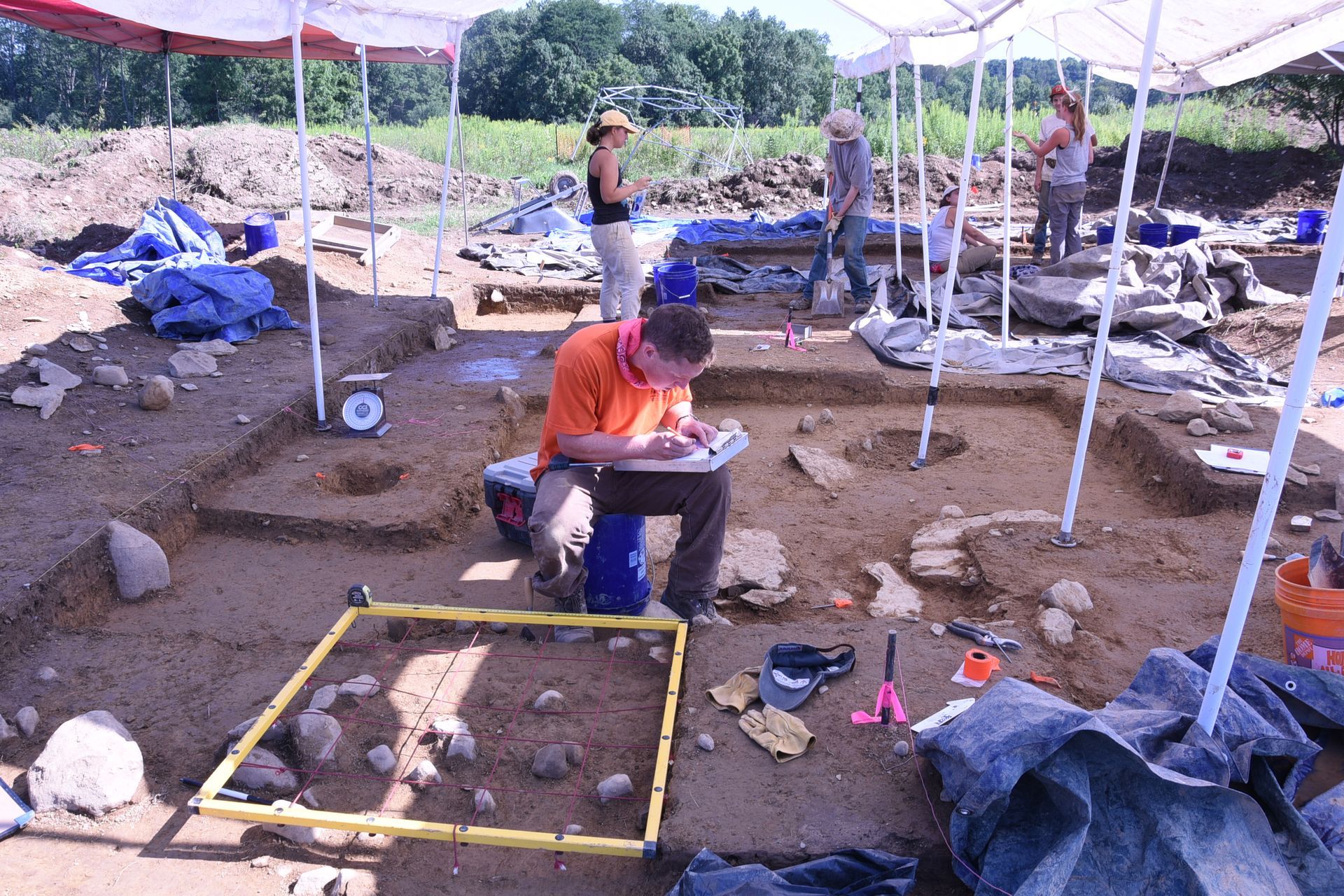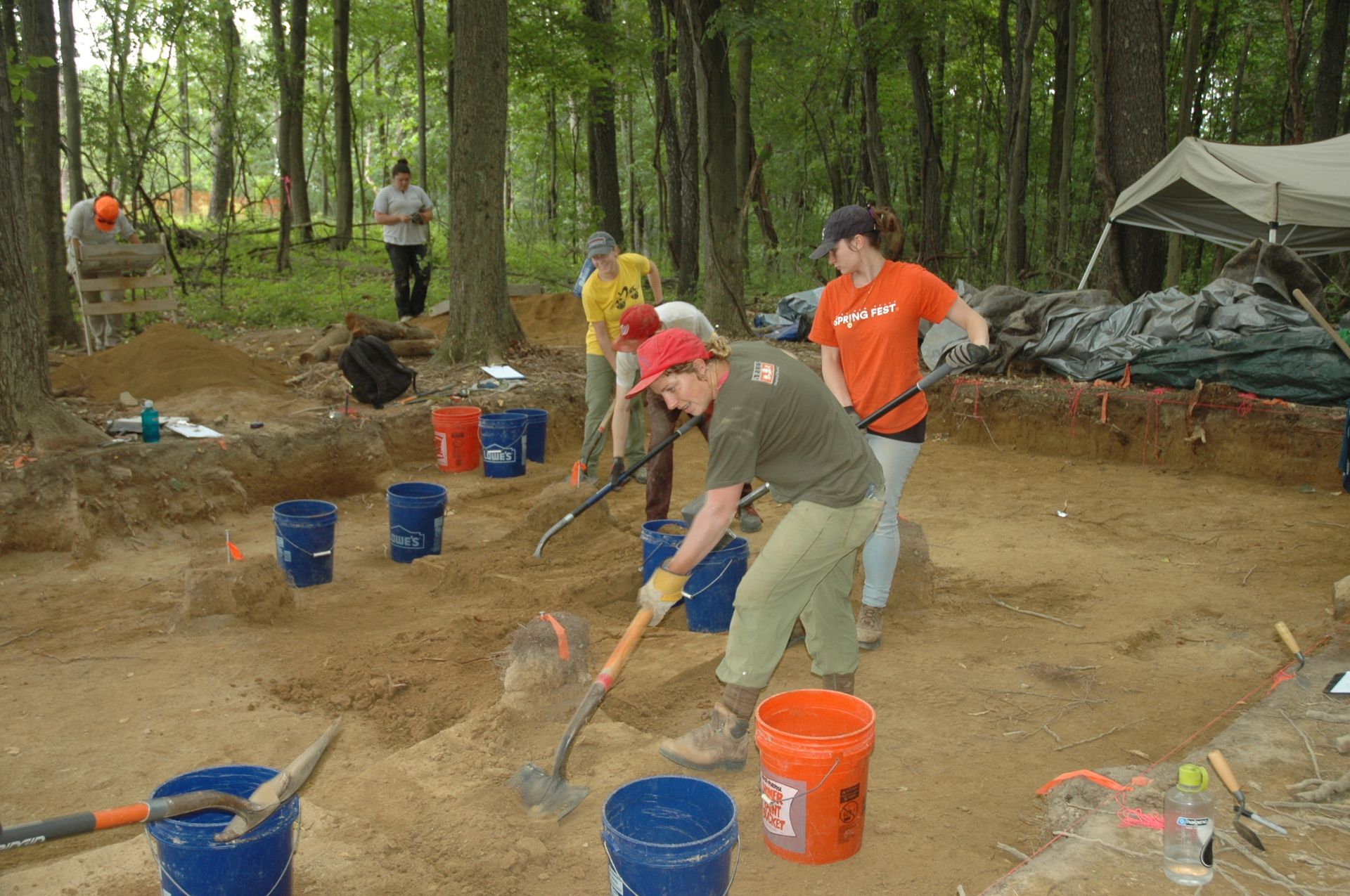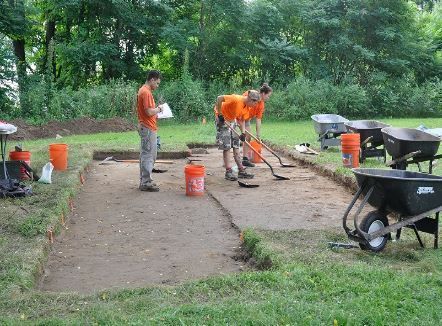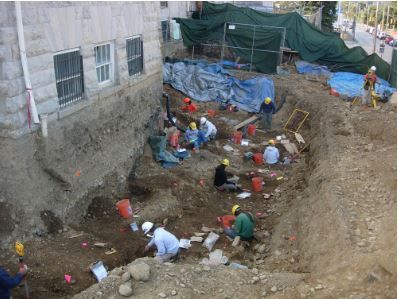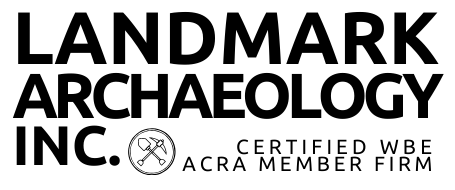Time-tested Historical Archaeology
Historial Archaeology
Newburgh Courthouse African-American Burial Project
Landmark Archaeology, Inc. recently completed fieldwork at the Broadway School African-American burial ground in Newburgh, New York. Archaeological investigations were prompted by the unanticipated discovery of three sets of human remains in March 2008 during the renovation of a public school building into a courthouse by the City of Newburgh under the direction of the New York State Office of Courts Administration. Initially treated as a crime scene and investigated by local police, City officials quickly realized that construction had encroached upon what is identified as the “Colored Burying Ground” on an 1869 dated map.
In May 2008, Landmark’s first efforts concentrated on the systematic examination of the location of the initial burial discoveries, about 1.5 meters below the surface grade of the new addition of the north side of the Broadway School. Three additional articulated human burials were identified shortly after initiating fieldwork. The graves were oriented east/west and lying in a supine position. Preservation of the skeletal remains was generally good. No personal items were recovered. Coffin wood was not present, though coffin nails were recovered from each grave.
Based on the identification of the three additional graves and cartographic evidence indicating that the 19th century cemetery extended into other areas of construction, Landmark was retained to systematically examine and disinter all graves within the 0.5-acre project area. Fieldwork was conducted and organized within a sequence of zone excavations that allowed construction activities to proceed uninterrupted throughout the duration of the four-month archaeological investigation.
In total, 106 graves were identified in the project area. Though post field osteological analysis has only begun, field examination of the cemetery’s population identified 19 children, 11 adolescents, 70 adults and six individuals indeterminate in age. The cemetery was organized along north/south rows with only one interment facing west. Personal items buried with individuals were scarce and very few pieces of clothing were recovered. The most common artifacts found in association with the burials were coffin hardware, buttons, buckles, and straight pins. Coins, two of which date 1832 and 1850, were found in several graves. Except for one coffin, substantial pieces of coffin wood were rarely observed. However, based on grave stains and the spatial patterning of coffin nails, most burials were interred in a six-sided “shouldered coffin” that tapered at the head and foot and was widest at the shoulder.
During the onset of the project, the City formed the Courthouse Burial Ground Working Group. Comprised primarily of Newburgh community leaders, the group was instrumental in establishing dialog between the descendant citizens of Newburgh, the City, Landmark, and the New York State Historic Preservation Office in terms of determining an acceptable level of effort and protocol for burial disinterment, post field osteological analysis, and planning a fitting memorial for onsite reinterment. An important aspect of the committee’s work was planning a series of brief ceremonial events that were held immediately prior to burial disinterment by Landmark. The ceremonies involved African, Native American and Christian religious elements and were attended by members of the community, City officials, construction workers, and archaeologists. The ceremonies provided an opportunity to celebrate human life (past and present), reflect on complex ethical issues, and a respectful venue to commemorate the dead.
The principal activities of an archaeologist are the location, surveying, and mapping of sites and and
excavation, and the classification, dating, and interpretation of materials to place them in historical context. With over 75 years combined experience, there is no company more qualified for this than Landmark Archaeology. We meet the challenge in every way, maintaining the highest degree of integrity for any and every project we manage. Landmark Archaeology takes pride in safeguarding the unique character of every project, providing superior archeology services to demonstrate our deep respect for historic sites and structures. We strive to ensure each archaeological exploration meets professional standards to ensure the value and importance of not only of the results of the excavation but for the location as well.
Why Us?
LANDMARK’S CULTURAL RESOURCE MANAGEMENT EXPERTS
providE the Best
POSSIBLE Service
Landmark Archaeology, Inc. is a small women-owned business that offers a wide range of cultural resource management and historic preservation services in the Northeast and Midwest United States. Our professional staff is well versed in laws, regulations and laws related to cultural resource compliance. Our decades-long experience ensures that our clients will navigate the federal Section 106 review and other state and local regulatory processes in the most timely and efficient manner possible.
ArchaeologiSt Professionals
Landmark Archaeology President and Principal Archaeologist Susan Gade, RPA, is directly involved in supervising field projects and artifact analysis, and writing proposals, research designs and reports. She has developed and implemented research designs for all levels of archaeological investigations for prehistoric and historic sites in the northeast and Midwest regions of the United States. Landmark Archaeology co-owner and Principal Archaeologist Derrick J. Marcucci, RPA, assists in administering the company while also conducting and supervising archaeological and historical research projects. He has has extensive experience applying GIS/GPS technology to CRM applications, and is currently is a New York Archaeological Council (NYAC) board member.
Clients of Landmark Archaeology
Landmark Archaeology, Inc. works with many state and federal agencies as well as private and public sector clients in compliance with federal (Section 106 of the National Historic Preservation Act) and state (e.g., Section 14.09 of the NYS Historic Preservation Act; SEQRA) laws relevant to cultural resources.
Federal & State Government Agency
- New York State Parks, Recreation, and Historic Preservation
- US Department of Veterans' Affairs
- Federal Department of Transportation
- Federal Emergency Management Agency
- Federal Highway Department
- New York Department of Environmental Conservation
- Natural Resources Conservation Service
- New York Power Authority
- US Army Corps of Engineers
- US Department of Agriculture
Public Sector
- Cambridge City School District ( New York)
- City of Saratoga Springs (New York)
- City of Newburgh (New York)
- Clifton Park-Halfmoon Public Library (New York)
- Clinton County Engineer (Iowa)
- Henry County Engineer (Iowa)
- Jackson County Engineer (Iowa)
- Jasper County Engineer (Iowa)
- Jones County Engineer (Iowa)
Private Sector
- Albany Pine Bush Preserve (New York)
- Amec Foster Wheeler (Massachusetts)
- Amedore Homes (New York)
- Barton & Loguidice, P.C. (New York)
- CH2M Hill, Inc. (Colorado)
- Chazen Engineering (New York)
- Clifton Park-Halfmoon Public Library (New York)
Archaeological Projects
Landmark Archaeology, Inc. has collectively conducted over 2,000 cultural resource management projects in the Northeast, Midwest, and Plains regions of the United States in the last 25 years. The projects range in size from one-day/one-person (Phase IA) field reconnaissance surveys to archaeological mitigations requiring large crews (20-30) and lasting several months. Many of our clients represent large well known corporate and federally funded entities that trust Landmark’s ability to navigate the complexities associated with compliance of Section 106 and other laws pertaining to our Nation’s cultural heritage. For example, Landmark is proud to have provided cultural resource services to the LEGO Company, organic food purveyor Amy’s Kitchen, Tesla, and the Argonne National Laboratory.
More Information
Landmark Archaeology, Inc. is a woman-owned, full-service resource management firm located in Altamont, New York specializing in historical archaeology in the Northeast and Midwest. With over 75 years of collective experience, no one in the industry has a better reputation or more keyed-in expertise for historical archaeology. Our knowledgeable team uses state-of-the-art equipment needed for precise and trusted historical archaeology. We strive to create strategies tailored to the individual characteristics of each historical archaeology project, ensuring that work is completed ethically and sustainably.
Give us a call today for all of your historical archaeology needs.
CONTACT US
We’ll get right back to you.
Frequently Asked Questions
We're here to help with any questions you may have about archaeology surveys.

